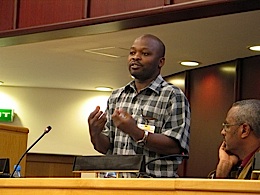 During 2007 – 2009, the Policy Processes team conducted research in seven districts of Kenya (Eldoret West, Mwingi, Nyeri South and Rachuonyo) and Malawi (Dedza, Rumphi and Thyolo), to examine the role and performance of the Ministry of Agriculture at district level, using interviews with key informants and focus group discussions. The research explored stakeholders’ views as to the role that the ministries should be playing in different contexts, what they actually do and why, and what factors impede the performance of their roles.
During 2007 – 2009, the Policy Processes team conducted research in seven districts of Kenya (Eldoret West, Mwingi, Nyeri South and Rachuonyo) and Malawi (Dedza, Rumphi and Thyolo), to examine the role and performance of the Ministry of Agriculture at district level, using interviews with key informants and focus group discussions. The research explored stakeholders’ views as to the role that the ministries should be playing in different contexts, what they actually do and why, and what factors impede the performance of their roles.
The main activity of the Policy Process team during Phase 2 (2009-2010) has been additional field work for the Ministries of Agriculture district case studies in Malawi and Kenya and dissemination of the survey results on the Ministry of Agriculture (MoA) services from all study districts.
Relevance of the Research Project
This study was inspired by the apparent return of agriculture onto the international agenda as a primary engine of growth and poverty reduction in predominantly agrarian societies But this is taking place against the backdrop of three distinct policy narratives about the role of MoAs. These are:
- MoAs having the capacity and policy clout to address the major constraints of agriculture in which case they ought to be strong and well funded;
- MoAs taking on a minimal role focused on oversight and regulation whereas the private sector (non-state actors) assume a dominant role in the agricultural sector in a free market environment; and
- MoAs in partnership with other state agencies should play a key role in addressing the coordination and intermediation of getting markets to work effectively while ensuring at the same time concerted the public efforts targeted to poverty reduction
The major focus of the study was therefore exploring how the MoA interact with other key players at the district level which, inter alia, include other government agencies, farmers, the private sector and NGOs. The underlying idea was to generate evidence on patterns and trends in the scope and leverage of the MoA in devising and delivery of agricultural services and policies with the view to drawing implications on their capacity to play a coordination role and be demand driven.
The justification for studying the MoA at the district level was that it is the best place to get insights into how the ministry interacts and cooperates with other stakeholders at field level which is as close as possible to the point of service delivery. This should in turn generate good insights to feedback up to central policy makers and serve as the basis for informing the subsequent phases of FAC’s endeavours.
Key Research Questions
Specifically, the study intended to provide insights to the following four fundamental questions:
- To what extent do MoA perceptions on its key functions match other stakeholders’ (particularly farmers) perceptions on what the MoA is doing as well as their expectations on what it should be doing?
- Is there a gap in the functions, activities, services being performed and delivered by MoA? If so, is this gap being filled by other players in the sector (NGOs? Private sector?)
- What impacts do internal constraints have on the ability of the MoA to perform its current functions?
- How has the performance of the MoA changed over time and why?
It also shed light on the following additional question:
5. What opportunities does administrative decentralisation (as promoted, for example, in the recent Kenyan constitution) present for the delivery of enhanced agricultural extension services to smallholder farmers?
Recent Project Activity
- Blessings Chinsinga carried out a monitoring study for the consortium of Farmers Unions, Malawi Economic Justice Network and Civil Society on Agriculture on the implementation of the 2009 subsidy programme. The results of the study were disseminated at a Civil Society platform in May 2009.
- Blessings Chinsinga carried out fieldwork on the MoA district level study in Rumphi district bringing the total number of districts covered to three. Data analysis started towards the end of the period.
- Blessings Chinsinga organised a National Workshop on 23 October 2009 to disseminate and discuss findings on the MoAFS district level study on management of extension services. The workshop was held in one of the districts (Dedza) and drew participants from the other two districts in the study: Thyolo and Rumphi. The MoAFS was represented by officials from the study districts and the MoAFS headquarters.
- Preparation of the Case Study report on extension services in Rumphi district (Blessings Chinsinga).
In Kenya, work is completed in Eldoret West district (previously Uasin Gishu North) and a draft report is ready. Our field researchers are due to make a final visit to Nyeri South before completing the report for that district. Initial findings from the work so far (including that conducted during the last phase) are that district offices in politically well connected districts are better endowed in terms of budget, personnel and other resources. However, even in politically well-connected areas, ongoing subdivision of districts (which is being pursued very aggressively in Kenya, such that what was once a division is now being upgraded to district status) has not been accompanied by sufficient extra resources.
As a result, capacity is under great strain. Looking across Ministries, the Ministry of Agriculture is better resourced and undertakes more activities at district level than the other rural development Ministries. Staff at the field level interact constantly; hence, the coordination problems resulting from the creation of multiple ministries are felt more at headquarters level than at district level.
